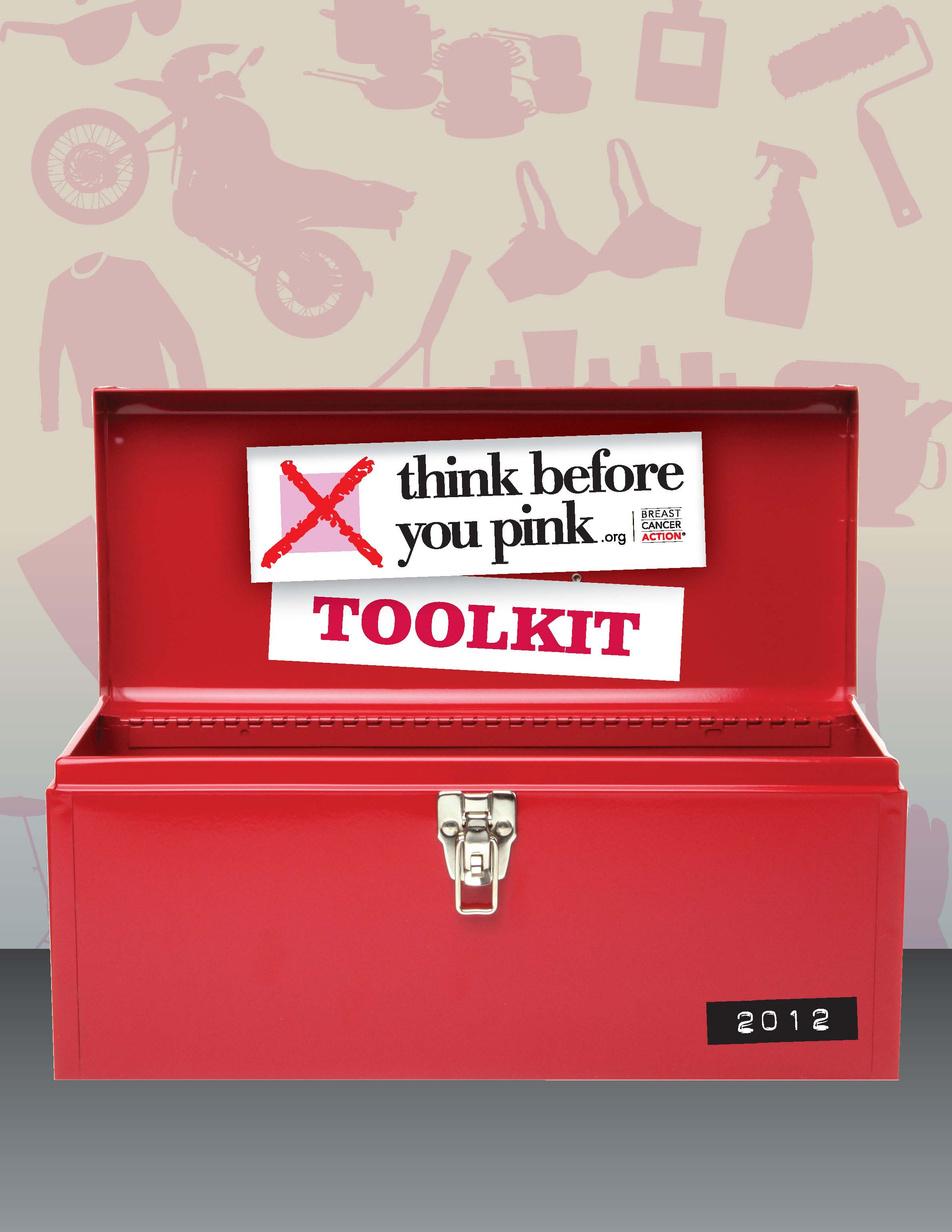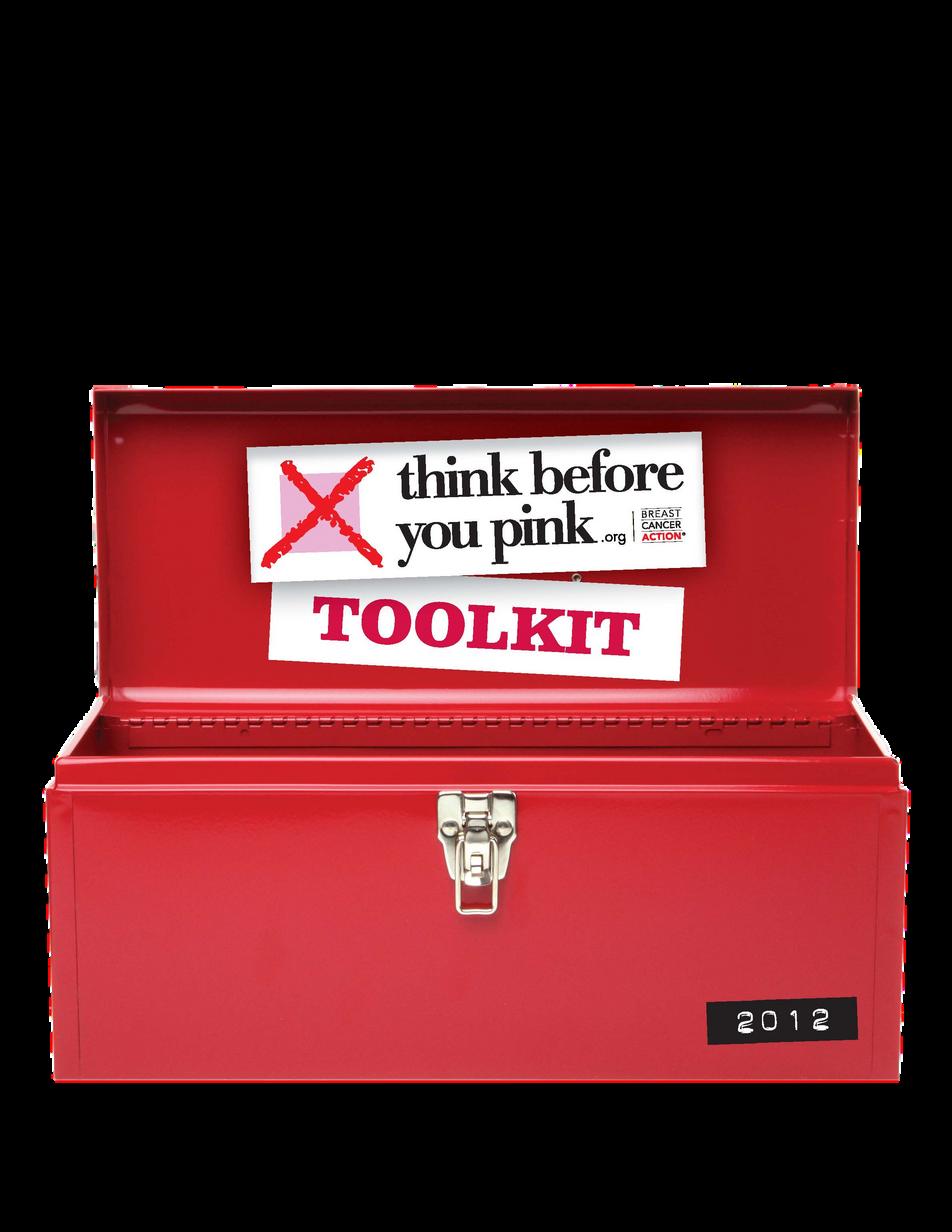THINK BEFORE YOU PINK







Breast Cancer Action is the breast cancer industry watchdog. We ignited a movement in 2002 when we were the first to call out pinkwashing and pink ribbon marketing culture. At that time, we coined the term pinkwashing and created the industry disrupting Think Before You Pink® campaign, and in 2012, BCAction launched the first version of this toolkit to provide our members with useful tools for action to change the conversation about breast cancer Since 1990, we’ve challenged the impact of pink ribbon marketing and culture and Breast Cancer Awareness Month (BCAM), or as we know it, Breast Cancer Industry Month.
The primary goal of Breast Cancer Industry Month has been to profit from pink ribbon products while using the goodwill of those that care about and have been impacted by this devastating disease. Despite billions of dollars raised for the cause from these promotions, who benefits the most from pink ribbon promotions: corporations, or people living with and at risk of breast cancer?
The American Cancer Society (ACS) predicted that in 2019, an estimated 268,600 new cases of invasive breast cancer would be diagnosed among people assigned female sex at birth.¹ Despite the successes in eliminating the stigma of breast cancer, better treatments, deeper understandings of the disease, and improved access for many, approximately 40,000 women still die each year ² The lifetime incidence of getting breast cancer has actually increased from 1 in 10 in the 1970s to 1 in 8 today
Over two decades of leading this work, our critical take on pink ribbon marketing and culture has transformed the conversation around breast cancer and pink ribbons However, this doesn’t mean that corporations have stopped using the urgency to end this disease to make a profit from breast cancer And as we continue to reckon with prevailing injustices that include racism, sexism, homophobia, and climate change, for profit industries are getting even more manipulative in their tactics to distract from the larger issues at hand while using them to increase their bottom lines.
Inside this toolkit, you will find information and tools to:
LEARN about the history of BCAction’s Think Before You Pink® campaign, the politics of breast cancer, and the truth about pinkwashing and cause marketing.
SHARE what you learn about critical questions to ask before you buy pink, how to talk to friends and family about walks and runs, FAQs about pink fundraising, and how to effectively use social media to change the conversation ACT to change the conversation by launching your own Think Before You Pink® campaign, writing a letter to the editor, supporting legislation that will move us closer to a decrease in breast cancer diagnoses, and supporting the vast Breast Cancer Action community of activists who want to end this public health crisis.
We need action that changes the ways profit driven industries do business; action that regulates toxic substances; and action that holds corporations accountable for the ingredients in their products that increase our risk of developing breast cancer. By joining together to take action that benefits the health of all people most at risk of breast cancer, not just individuals, we can prevent future generations from receiving a breast cancer diagnosis
Less pink, more action, because action speaks louder than pink!
©Breast Cancer Action, Some Rights
NoDerivs
0 Unported License
view a copy
org/licenses/by
nd/3 0/ or
In the early 1990s, Charlotte Haley, alarmed by the number of breast cancer diagnoses in her immediate family, attached peach-colored ribbons to postcards and distributed them to everyone she knew. The postcards read: “The National Cancer Institute’s annual budget is $1.8 billion, only 5 percent goes for cancer prevention. Help us wake up our legislators and America by wearing this ribbon.” Her outrage was over a lack of federal commitment to cancer prevention. Recognizing the power of Haley’s ribbon, Self magazine and Estée Lauder cosmetics reached out to her requesting use of her peach ribbon as a promotional tool during Breast Cancer Awareness Month. Alexandra Penney, of Self magazine, said, “[Haley] wanted nothing to do with us. Said we were too commercial.” Self and Estée Lauder consulted lawyers, who told them they needed only to use a different color. Focus groups confirmed pink as a soothing, comforting, quieting color And the pink ribbon was born
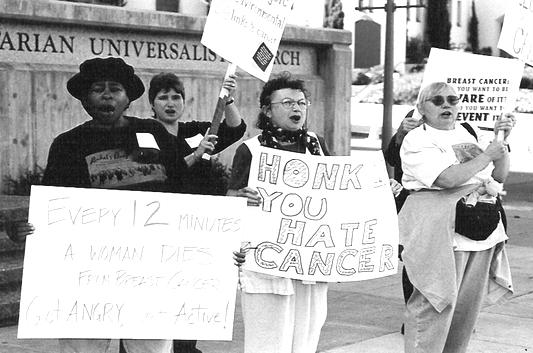
Breast cancer has come a long way in the last 30 years. Activists have successfully demanded access to mammograms through insurance plans and free screening services; many pharmaceutical treatment options are available, with more being researched; radical mastectomies without patient consent are no longer the norm; and the bioscience industry has developed an understanding of genetic factors, which has led to the isolation of genetic mutations related to breast cancer.
Indeed, the numerous pink ribbon awareness campaigns have undoubtedly helped destigmatize breast cancer and put it on the women’s health map. However, the corporate takeover of the pink ribbon has so narrowly focused popular attention on awareness that prevention continues to be overlooked. Each year pink ribbon cause marketing generates hundreds of millions of dollars. In fact, the term “cancer industry” is now frequently used by breast cancer activists and the media to describe corporations, organizations, and agencies that use pink ribbons to profit directly from breast cancer.
Despite the billions of dollars that have been spent on pink ribbon awareness campaigns, research, screening, and testing, people continue to get breast cancer. Do you ever stop to ask yourself why? Corporations generate huge profits by linking their products to a pink ribbon they profit financially, and they profit from the positive association of linking their company with a worthy cause. However, many of these companies, including cosmetic and car companies, are themselves contributing to causing breast cancer. Breast Cancer Action believes that instead of profiting from breast cancer, these corporations, if they want to make a difference, should be taking action to prevent us from getting sick in the first place The pink ribbon will never get us as far aswe need to go to end this crisis, because pink ribbons are tightly bound up with corporate profits. Pink ribbons have become a distraction. They divert our attention away from the root causes of this disease. Pink ribbons politely ask us to spend our money on many products that may increase our risk of developing breast cancer. For the sake of all our lives, we must do more than shop (and walk and run), because despite our best intentions, these acts have not brought an end to the breast cancer crisis
In 2002, Breast Cancer Action launched Think Before You Pink® in response to concerns about the overwhelming number of pink ribbon products and promotions flooding the market. Think Before You Pink® calls for more transparency and accountability from companies that take part in breast cancer fundraising, and encourages consumers to ask critical questions before purchasing pink ribbon products. BCAction coined the term “pinkwasher” as part of the Think Before You Pink® campaign.
A company or organization that claims to care about breast cancer by promoting a pink ribbon product, but at the same time produces, manufactures and/or sells products that contain ingredients that are linked to the disease. Over the past 20 years, Think Before You Pink® has changed the conversation around breast cancer cause marketing. The term “pinkwasher” is now a common term used freely by many advocacy organizations and the media to describe the hypocrisy and lack of transparency that surrounds breast cancer fundraising and Breast Cancer Industry Month. Think Before You Pink® campaigns have successfully targeted cosmetic giant Avon, car manufacturers Ford, Mercedes, and BMW, and Yoplait yogurt maker General Mills.
In 2020, Breast Cancer Action coined the term “pink policies” as a part of the campaign, "We Can’t Be Pink’d," which called out the federal administration’s failures to address the breast cancer crisis.
Pink Policies are political pinkwashing in action They are policies, or a lack of policies, that fail to protect people living with breast cancer and increase breast cancer risk for all people, especially for women, people of color, and low income people.
The breast cancer pink ribbon campaign is one of the most successful marketing campaigns of the 21st century, but it's real impact on the breast cancer crisis is minimal when we consider the billions of dollars raised for retailers and mega nonprofits Cause washing has also evolved alongside the rise of the pink ribbon marketing campaign, and can be defined as a company’s deceptive strategies to appear to care about a cause, while in reality taking no action on it, or worse yet, actively working against it, while profiting from the appearance of altruism. This is done around a variety of causes; in breast cancer fundraising we know it as pinkwashing, in environmental justice it’s termed greenwashing, and recently the term “woke washing” has been employed to describe companies that market themselves as anti-racist or social justiceoriented, despite the true motivator of profit over working toward justice.
We’ve seen an increase in these types of campaigns alongside the rise in public interest in the causes they claim to support, including breast cancer, anti racism, or the climate crisis. Motivated by profit over public health, these types of campaigns are both unique to and normalized under capitalism. For example, Earth Day marks the anniversary of the birth of the environmental movement, and led to the passage of landmark environmental laws in the United States, including the Clean Air, Clean Water and Endangered Species Acts and the establishment of the Environmental Protection Agency (EPA). In April, companies market products that are “good for the environment” and “natural,” however, these revenue-producing gimmicks are rarely tied to structural change solutions. Pride Month
honors the historic 1969 Stonewall riots for LGBTQ rights, and has been similarly commodified. Like the pink ribbon, the rainbow has been a symbol of solidarity among members of the LGBTQ communities and their allies, and a huge variety of companies have capitalized on the opportunity to monetize this by “rainbow washing” and producing rainbow apparel, accessories, and other products. The problem? These companies are motivated by money, and rarely espouse pro LGBTQ values or support programs led by LGBTQ folx. Another recent example is Juneteenth. Recognized in 2021 as a nationally-observed holiday, Juneteenth takes place on June 19th and celebrates the freedom of African and African American people from slavery. As the recognition of this holiday has grown, so too has the availability of corporate Juneteenth paraphernalia, which makes a quick buck and provides feel good marketing opportunities for the companies running these campaigns, but in practice does nothing to address the ongoing impacts and consequences of over 400 years of enslavement that are still felt today.
These are only a few examples of causewashing. As we’ve learned from being critical of how pink ribbon marketing culture has usurped the goodwill of the breast cancer community, the false narratives of cause washing have real impacts on people, and they can damage communities and harm the environment. These tactics divert attention away from harsh realities, provide platforms for misinformation, and misdirect, toward consumption, the public’s growing desire to be a part of a solution.
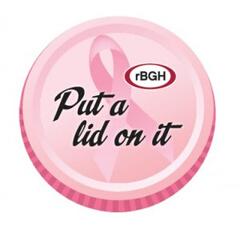
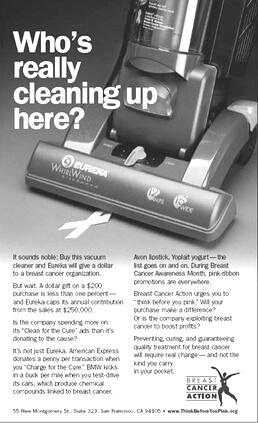
BCAction formally launches the Think Before You Pink® campaign and creates resources highlighting critical questions that consumers should ask about pink ribbon products. We take out a ¾ page ad in the New York Times and hold the first annual “Parade of Pink.”
Eureka and American Express stopped cause marketing.
BCAction focuses on Yoplait’s pink lidded yogurt, sold to raise money for breast cancer, but made with dairy stimulated with the hormone rBGH. Thousands of letters are sent to General Mills from BCAction supporters to demand they remove rBGH from their dairy products. SUCCESSES
General Mills and Dannon who make 2/3 of America’s dairy products now manufacture rBGH free products. BCAction is awarded first place at the 2009 BENNY Awards for an outstanding corporate campaign victory.
BCAction launches a letter writing campaign to call out the health hypocrisy of “Buckets for the Cure,” a partnership between KFC and Susan G. Komen for the Cure.
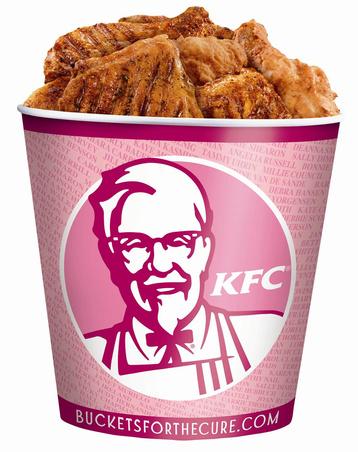
Nearly 5,500 letters are sent to Komen, and BCAction receives tremendous media attention surrounding the campaign, including from The Colbert Report.
BCAction hails Susan G. Komen and Baker Hughes’ pink fracking drill bits for the cure as “the most egregious example of pinkwashing” we’ve ever seen.
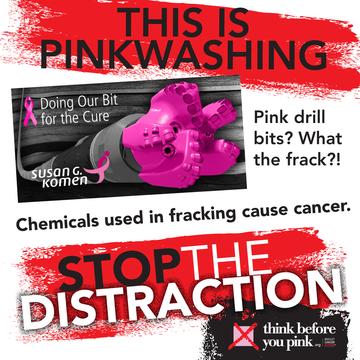
The campaign ignites an incredible groundswell of grassroots activism: 168,700 outraged people signed a petition demanding thenation’s largest breast cancer charity break ties with the fracking industry and take a stand against this toxic process. BCAction delivers the petitions directly to Susan G. Komen, protests at the Pittsburgh Steelers football game where Komen was scheduled to accept Baker Hughes’ check for $100,000, and is featured on The Daily Show with Jon Stewart.
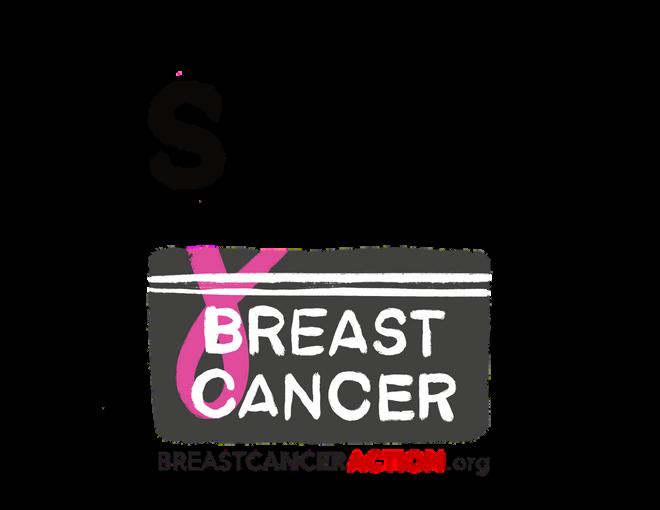
BCAction calls out Ford Motor Company for driving up the risk of breast cancer by continuing to focus on and build cars that produce cancer causing emissions, all the while pinkwashing these efforts by touting their commitment to fighting breast cancer through the Warriors in Pink Program
Twenty influential health and environmental groups endorse the campaign. We lead a day of action at Ford’s Detroit headquarter and hand delivered 45,000 petition signatures demanding that Ford stop pinkwashing and commit to producing lower emission vehicles.
BCAction calls out Susan G. Komen® and Bank of America for their Ribbon Banking Program, made up of a credit and debit card. Our campaign is unabashed in its message: Susan G. Komen® cannot con to promote themselves as advocates for people with breast cancer w partnering with a major fossil fuel funder, given the undeniable links between the fossil fuel continuum and breast cancer risk.
The campaign garners media coverage with a reach of 900,000+ peo and culminates in direct action as our team joins the Fossil Free Fut Day of Action in San Francisco amongst coalition partners.
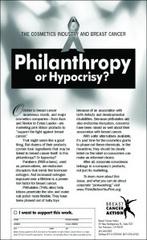

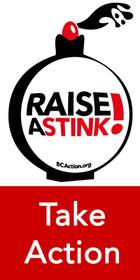
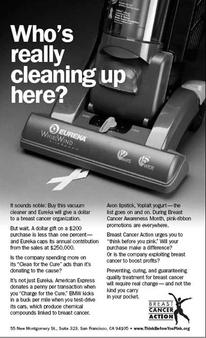
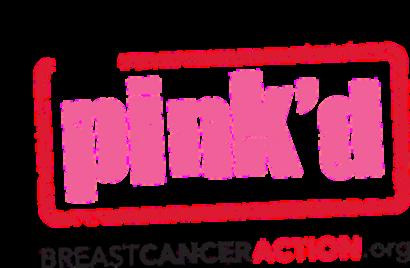
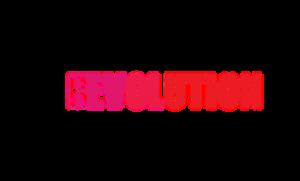
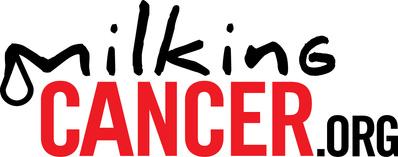
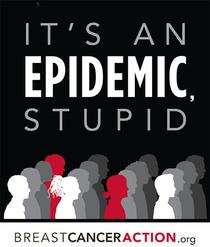
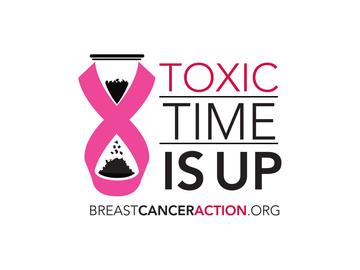
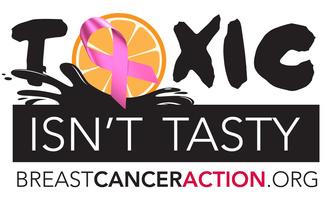
The abundance of breast cancer awareness programs in recent decades means that today everyone is aware of breast cancer Yet, despite all this awareness, BCAction continues to work to dispel widespread myths and misconceptions.
Today, people assigned female sex at birth in the United States have a 1 in 8 chance of developing breast cancer during their lifetime, which means that if each of these people lived to age 85, 1 in 8 would develop breast cancer.³
In the 1970s a person assigned female sex at birth’s lifetime risk was 1 in 10.5.⁴ Breast cancer mortality rates have been higher for Black women than any other U.S. racial or ethnic group While Black women’s incidence rates for breast cancer once were lower than white women, in recent years, Black women's incidence rate has caught up to that of white women.⁵ Non-Hispanic Black women have higher incidence rates than non-Hispanic whites before age 40 and are more likely to die from breast cancer at every age.⁶
Family history and heredity accounts for 10 percent of all breast cancer cases, at most.⁷
Fewer than half of all breast cancers (just 30–50 percent) involve one or more of the following known risk factors: family history; early menarche (i e , menstruation before age 11) or late menopause (age 51 and over); bearing children later in life (age 35 and over) or no childbirth; hormone replacement; alcohol consumption; and exposure to ionizing radiation (e.g., x-rays, mammograms, nuclear power plants).⁸
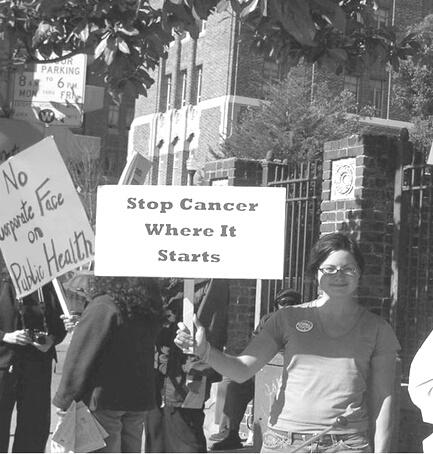
More than half of all breast cancers—50–70 percent of all cases—are from as yet unknown causes, leaving us with a lot we have yet to understand about breast cancer.⁹
In April 2010, the President’s Cancer Panel declared: “The Panel was particularly concerned to find that the true burden of environmentally induced cancer has been grossly underestimated [and] ... the American people even before they are born are bombarded continually with myriad combinations of these dangerous exposures.” They urged the President ”to use the power of [his] office to remove the carcinogens and other toxins from our food, water, and air that needlessly increase health care costs, cripple our Nation’s productivity, and devastate American lives.”¹⁰
Throughout our lives, we are all exposed to multiple toxins through our air, water, food, homes, and workplaces. Some of these exposures can be limited by our choice of household cleaners, beauty products, and food. But the majority involves exposures we can’t control. Xenoestrogens are manmade chemicals that mimic estrogen in our bodies and have been shown to increase women’s risk of breast cancer. These chemicals are found in many places in our environment, including personal care products and cosmetics (e g , parabens), weed killers that make their way to our water sources (e.g., atrazine), food preservatives (e.g., butylated hydroxyanisole), baby bottles (e.g., BPA), and plastic containers and toys (e.g., phthalates).
Today, less than 10 percent of breast cancer research funding goes toward understanding environmental causes of breast cancer
There are major gaps in the regulations of chemicals.
Of the more than 40,000 chemicals used in consumer products in the US, according to the Environmental Protection Agency, less than 1% have been rigorously tested for human safety.¹¹
Since 2016 the EPA has completed determinations on 3,645 new chemicals. As of June 2022, there are 348 active cases of chemicals that still need review. This makes it hard for consumers to make fully informed decisions regarding the safety of products.
The Toxic Substances Control Act of 1976 regulated chemicals in the United States for 30 years. Major loopholes in this law included: (1) the chemical industry is not required to prove a substance is safe before putting it out on the market, and (2) manufacturers are allowed to keep certain ingredients secret from the public in the name of “trade secrets ”
We must work together to create the systemic changes necessary to address the crisis, put public health before profits, and stop breast cancer before it starts.
We all want to make a difference in the breast cancer crisis. Companies are selling pink ribbon products that supposedly raise awareness of and money for breast cancer. But did you know that these pink ribbon products may not be making the positive impact the companies claim? These four critical questions for conscious consumers can help you make sense of the pink ribbon madness.
How much? Any company can put a pink ribbon on its products. The widely recognized pink ribbon symbol is not regulated by any agency and does not necessarily mean it effectively combats the breast cancer crisis. Some products sport pink ribbons to try to communicate that they are “healthy” and don’t contribute to breast cancer, such as a number of natural health and beauty products. Other products have a pink ribbon in order to indicate that the company supports breast cancer programs even if the company’s contributions are not tied to the purchases of the specific product bearing the ribbon. Still other companies give a portion of an item’s cost to a breast cancer organization but may require further action on the part of the consumer for the donation to be realized. Can you tell how much money from your purchases will go to support breast cancer programs? If not, consider giving directly to the charity of your choice instead.
EXAMPLE: In 2019, Beautyblender® sold an exclusive pink makeup sponge in partnership with the Breast Cancer Research Fund. Purchase of the exclusive pink sponge was not connected to their set donation of $20,000 though they marketed that purchasing the pink sponge would support the “breast cancer cause.”¹²
What will they do with the funds, and how do these programs turn the tide of the breast cancer crisis? Many companies that sell pink ribbon products and donate a percentage of each sale to breast cancer programs fail to indicate which of the many different breast cancer organizations will get the money Furthermore, the consumer is left to trust that these organizations are engaged in work that is meaningful and makes the greatest difference. If money goes to “services,” are they reaching the people who need them most? How do screening programs ensure that people can get treatment? And how do breast cancer awareness programs address the fact that we already know that breast cancer is a problem, and that action is needed in order to end the crisis? Does the money go to truly addressing the root causes of the disease, like social inequities that lead to women of color and poor women dying more often of breast cancer, or environmental toxins that are contributing to high rates of breast cancer? Before donating, check the recipient organization’s website to make sure that its mission and activities are in line with your personal values If you can’t tell, or you don’t know what the organization does, reconsider your purchase.
EXAMPLE: In 2019, breast cancer activists launched http://curekomen org/ in efforts to expose the Susan G. Komen Foundation’s misuse of donations, revealing that only 19% of the raised funds are going to breast cancer research.
Has this maximum donation already been met? Can you tell? Some companies that indicate that a portion of the proceeds from the sale of a particular pink ribbon product will go to support breast cancer programs put an arbitrary “cap” on their maximum donation Once the maximum amount has been met, the company may continue to sell the product with the pink ribbon without alerting customers that no additional funds will be donated to breast cancer organizations. This means you may be buying a product for which none of your purchase price will go to a breast cancer cause but only to the bottom line of the company.
EXAMPLE: In 2022, Bumble and Bumble donated 20% of the proceeds for their best-selling product in a limited-edition pink bottle to the Breast Cancer Research Foundation; however, the donation was capped at $20,000 regardless of the sales. This hair product company is owned by Estee Lauder; The Lauder family has an estimated net worth of 40 billion dollars.¹³
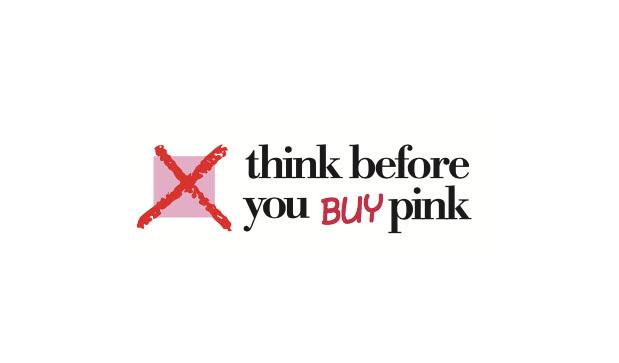
What is the company doing to ensure that its products are not contributing to the breast cancer crisis? Many companies have sold pink ribbon products that are linked to increased risk of breast cancer. We believe that companies that are profiting from building a reputation based on their concern about breast cancer have a responsibility to protect the public from possible harms when scientific research indicates that there is a risk or plausible reason for concern. Some of the earliest cause marketing companies were well-known cosmetics companies that continue to sell cosmetics containing chemicals that have been linked to breast cancer. Even car companies have gotten in on the action and sell cars that emit toxic air pollutants in the name of breast cancer. In considering a pink ribbon purchase, does the product contain toxins or otherwise increase the risk of breast cancer?
EXAMPLE: Since 2011, Pantene®, a hair product brand owned by Proctor and Gamble (P&G) has partnered with the American Cancer Society® to host Beautiful Lengths, a program to encourage folks to donate their hair and make wigs for people with breast cancer The program claims to help people that use Pantene products to grow “long, strong and beautiful hair” to donate. However, the company uses toxic chemicals that have recently been recalled. In 2021, P&G recalled more than 30 products due to the presence of benzene, a cancer-causing chemical.
If you have doubts about your pink ribbon purchase after reviewing these critical questions, consider writing a letter asking the company to be transparent about its donations.
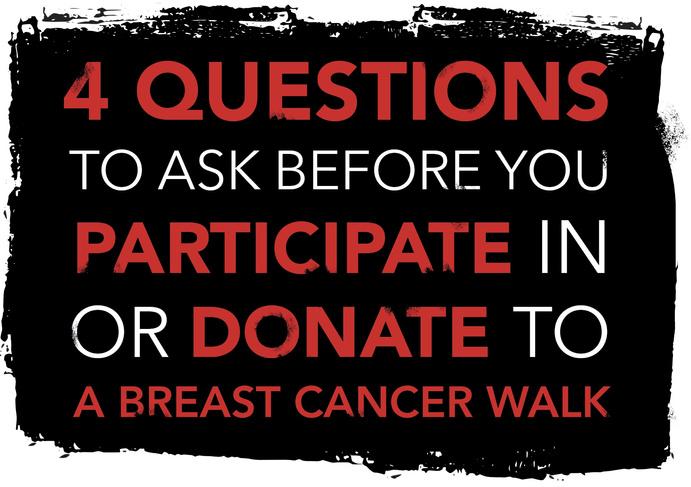
Almost all of us have at one point or another been asked to support friends and family who are looking for sponsors for their walk or run benefiting a breast cancer organization. You may have even participated in one yourself. BCAction recognizes and honors the personal commitment, passion, and camaraderie involved in many of these events, as well as the personal benefit of exercise In addition, walks and runs can be a terrific opportunity to connect with others and feel less alone in one’s cancer experience. But walks and runs mainly occur as fundraisers for breast cancer.
BCAction’s concerns with walks include:
The enormous overhead of these events represents a significant cost and, by most accounts, drains more than half of the money raised by participants. Donors and sponsors often don’t realize that most of their money is going to pay for the walk/run itself. In contrast, donating directly to breast cancer organizations can put 100 percent of that money to work.
Few if any of the organizers of these fundraising events clearly explain what the money that is donated to breast cancer organizations is used for. “Awareness” is one of the most common aims of these walks. While we are all aware breast cancer is a problem, too little funding goes to addressing the root causes of the disease. Ask the organizers where the money goes and how it affects the breast cancer crisis.
Although organizers and participants claim these events raise awareness, most people involved acknowledge that sponsors are supporting the individual person rather than demonstrating and deepening their concern about breast cancer. Furthermore, there are questions about what kind of awareness is raised. Do these walks educate people about the surprising facts and ugly truths of breast cancer? Do they further the growing perception that breast cancer has too much of the limelight while other diseases need more funding?
The sheer number of human hours spent by millions of Americans in preparing, training, and fundraising for these events represents a resource at least as valuable as the money raised. BCAction believes that if the same energy and time were focused on addressing the root causes of the breast cancer crisis, we might have more to show as a result
A lot of corporations have spent years linking their brand to breast cancer cause-marketing. However, many of these companies have not taken steps to make sure that their products are safe and don’t contribute to the breast cancer crisis. For instance, Avon sponsors breast cancer walks every year but uses toxins linked to breast cancer (including parabens and phthalates) in some of its cosmetics
For these reasons, BCAction believes there are more effective ways to address the breast cancer crisis than participating in a walk or run.
It can be challenging to talk about your concerns with breast cancer walks and runs when you are asked to sponsor someone who believes he or she is making a difference. We have collected some tips for talking to walkers/runners:
➢ Recognize the individual’s enthusiasm and interest in supporting those affected by breast cancer.
➢ Acknowledge that these events can be great opportunities to connect with others and share similar experiences.
➢ Explain your concerns with the efficiency, transparency, and efficacy of the walks and runs despite the widespread appeal of these events.
➢ You can always let the person know that, although you would prefer to abstain from funding or participating in the walk/run, you personally support them and you would gladly make a donation in their honor to a breast cancer organization with which you feel comfortable.
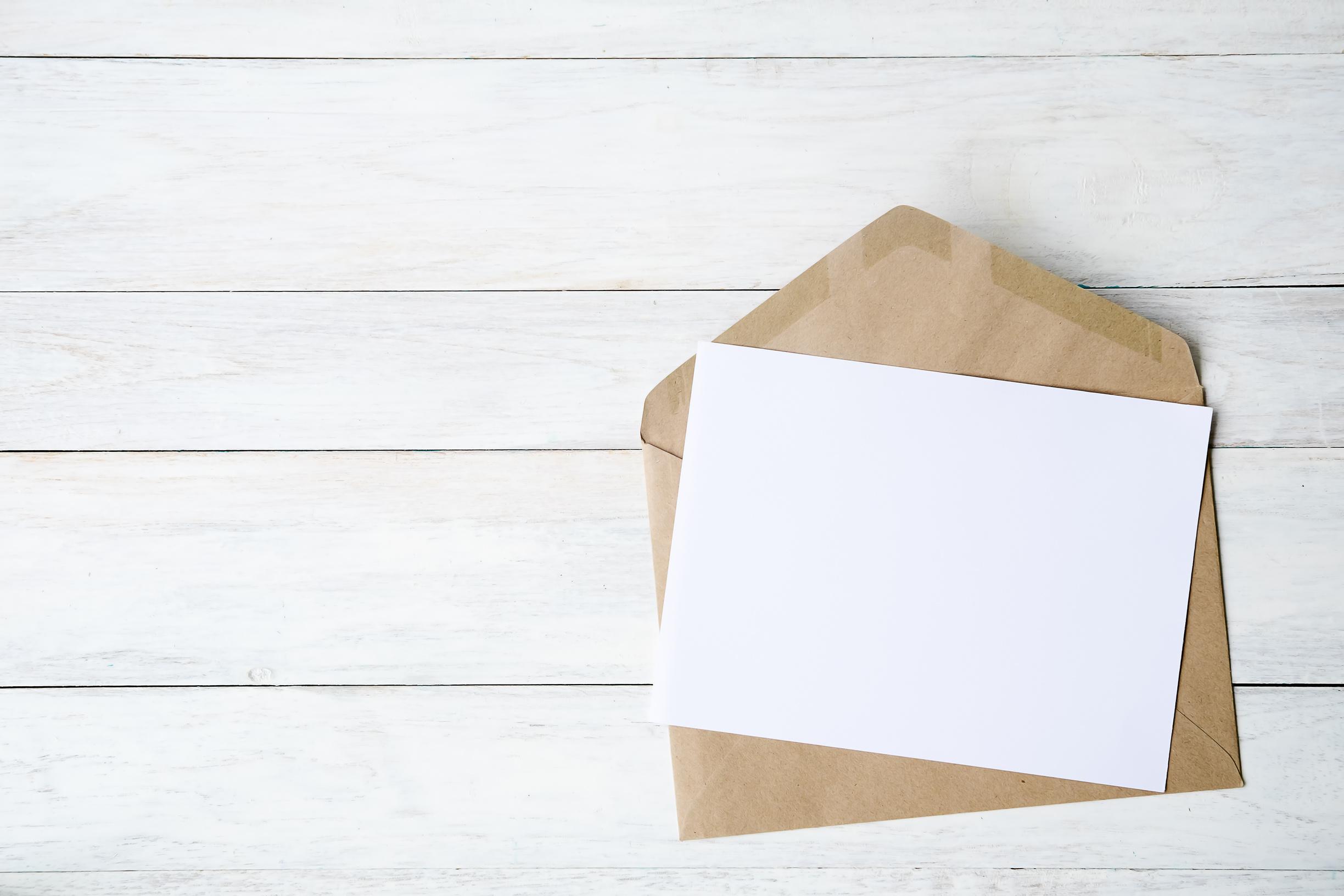
You may find it helpful to use the letter below as a template to respond to a friend who asked for sponsorship for a popular breast cancer walk. While you will want to write your reply in your own words, we are including this sample so that you can see how someone else has handled this sensitive issue
Dear[Friend],
Thankyou for reaching out to let me know aboutyour upcoming walk/run and inviting me to sponsor
you. I know how passionate you are about this cause, and I also am deeply alarmed by the breast cancer
crisis. I admire your commitment and want you to know that I personally support you and your
passion. However, I have some concerns about these walk-for-breast-cancer events. Since you’ve
asked me to sponsor you, I want to share with you some of what I’ve learned about breast cancer
walks/runs. I was dismayed to learn that most of the money raised by walkers/runners goes to pay for the
overhead and costs associated with putting on the event. Additionally, I have concerns about those
treatmentandoutcomes, etc.
funds thatmake itto a breastcancer organization andwhatprograms are funded. Specifically, Ithink
we have enough awareness already, and I want to see more resources going into systemic change to
address the root causes of the disease, not to mention funding for metastatic disease, inequities in
IwanttobesureyouknowthatIsupportyourpersonalcommitmenttothisissue, andinhonorofyour
efforts, I have decided to donate to Breast Cancer Action in your name, because I believe that this
organization always puts patients before profits and addresses the root causes of the breast cancer
crisis. Please let me know if you want to talk more about my decision or the work of Breast Cancer
Action.
Here are some questions we often hear when having conversations about pink ribbons, breast cancer, and what’s really going on with the disease. We hope the questions and answers below will help you have your own mindchanging conversations with friends and family.
How do pink ribbon promotions work? Often, a company puts a pink ribbon on a product (e.g., toilet paper, wine, macaroni, chocolate, tote bags) and when someone buys that product, some of the money goes to a breast cancer organization the company has partnered with This lets a company “brand” itself as caring about women and breast cancer, which supports overall sales for the company. Alternatively, a company puts a pink ribbon on one of its products and consumers think their purchase will support a breast cancer organization, but the company is just “promoting breast cancer awareness” through the pink ribbon on their product. Because the pink ribbon is not regulated, consumers must look beyond the ribbon to know what is going on.
Why criticize companies that raise money for breast cancer? BCAction is not opposed to companies donating to support breast cancer
organizations. Our concern is that every year, consumers spend millions of dollars on items with pink ribbons because they’ve been led to believe that their purchases will help end the breast cancer crisis. More often than not, these purchases are not as effective as people think: typically, very little money from each purchase goes to programs or research, and often the emphasis is on awareness rather than prevention. Rather than focus on buying pink ribbon items, we encourage people to get involved with breast cancer organizations that are engaged in work in alignment with your vision for how to address the breast cancer crisis, whether financial support and access to treatment for people living with breast cancer, focusing on prevention, providing services to the underserved, or innovative research
The worst part of pink ribbon marketing is “pinkwashers,” or companies or organizations claiming to care about breast cancer by promoting a pink ribbon product, but at the same time producing, manufacturing, and/or selling products that are linked to the disease. Companies are profiting from a disease they help create, and we think we deserve better.
Shouldn’t companies be commended for donating some of their profits to a good cause? Isn’t any money for breast cancer good? “Better than doing nothing” is not good enough. While the interest in breast cancer fundraising is encouraging, we often have no idea how much these companies are raising or how it’s being spent. What happens to the money that does make it to the cause? Is it doing anything worthwhile for people living with, or at risk for, breast cancer? We think the huge amount of pink ribbon fundraising allows people to think the problem is taken care of when in fact the problem is not any closer to being solved. If consumers think they’re doing something meaningful about breast cancer by participating in cause-related marketing campaigns, the real work that needs to be done around treatment, access to care, and true prevention will continue to be underfunded and ignored. In effect, pink ribbon fundraising is diverting and pacifying the public into thinking we are addressing breast cancer issues while issues of prevention are ignored.
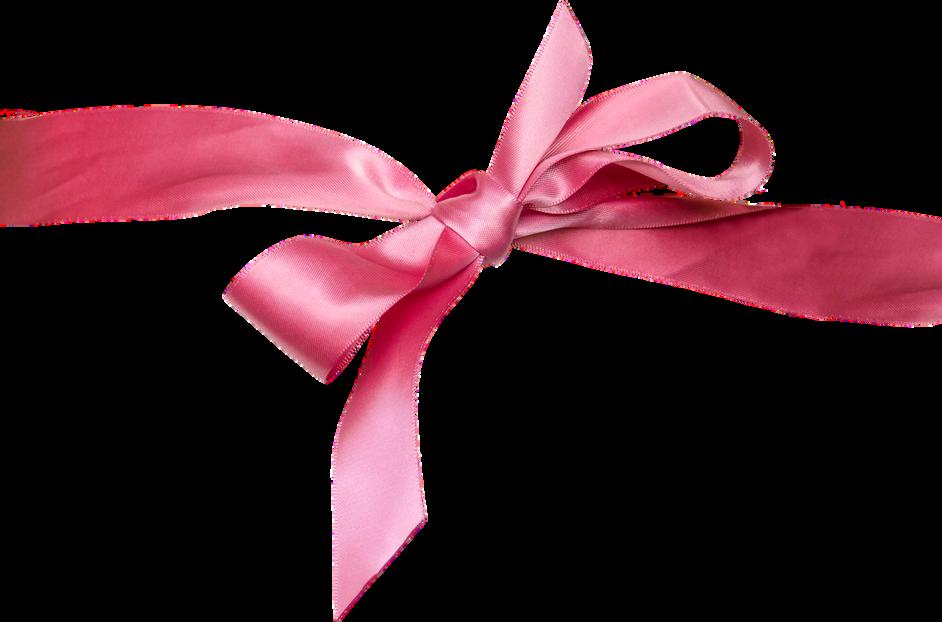
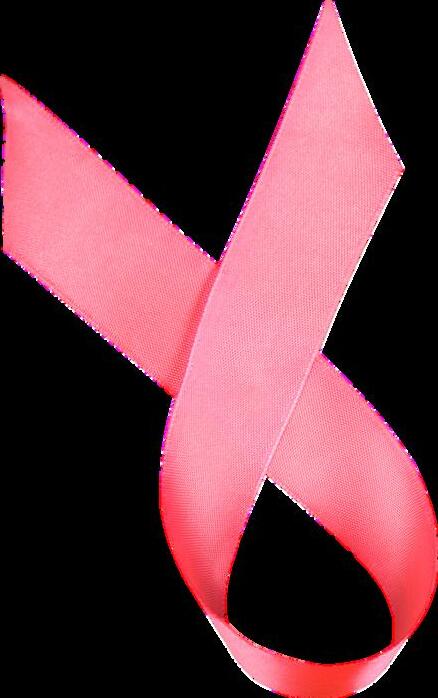
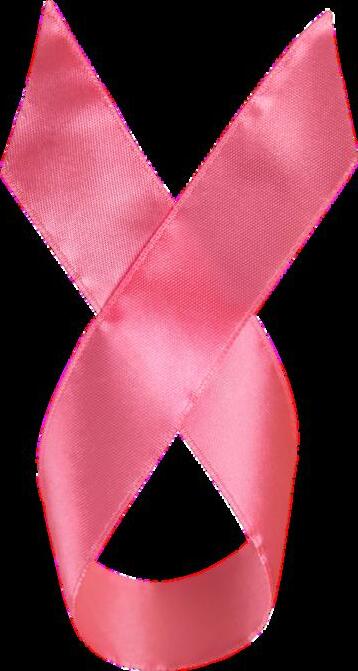
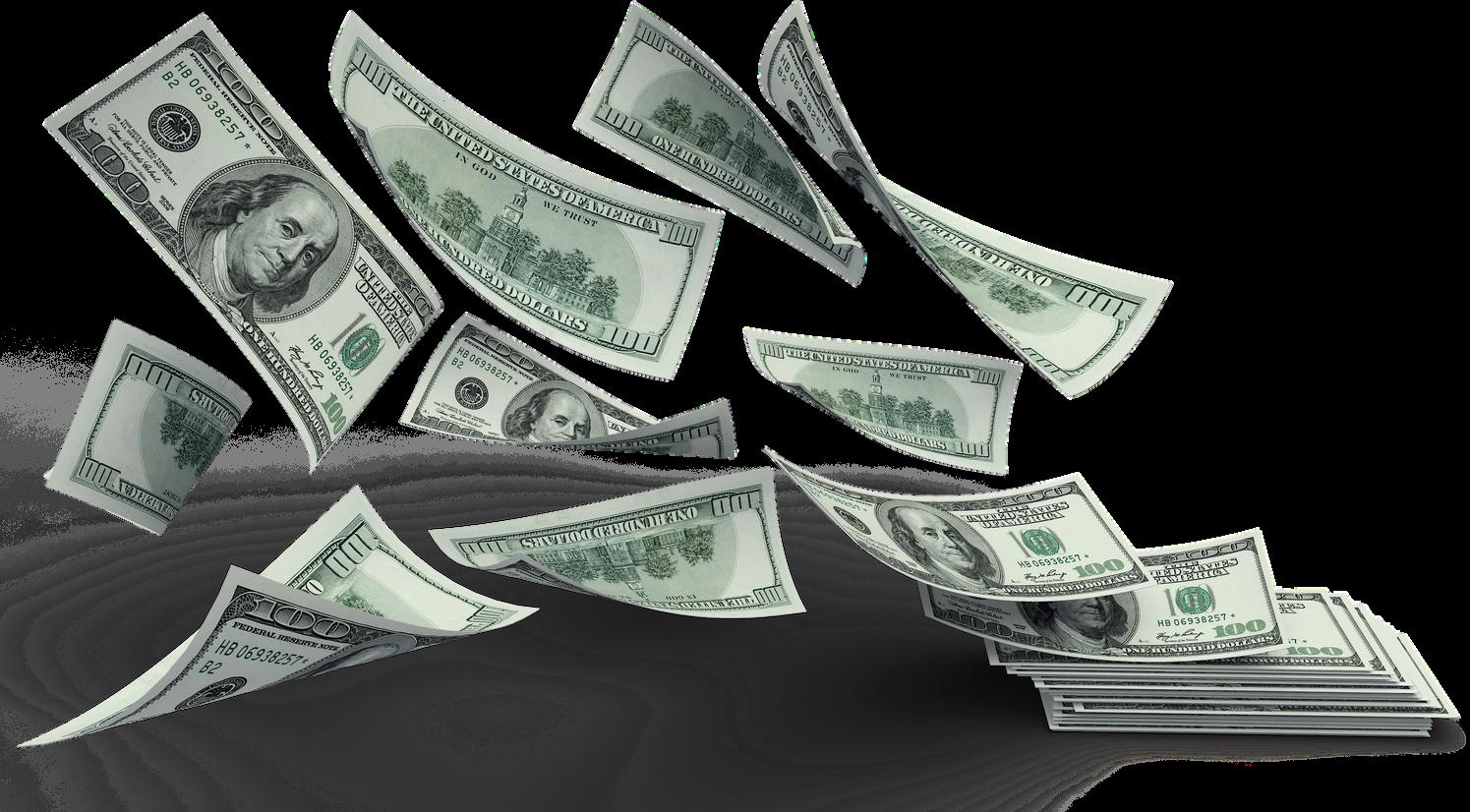

So what would you like me to do instead? You’ve taken the first step—by asking critical questions and understanding more about the politics of breast cancer you can now make your own assessment, based on your personal values, about where and how you want to make an impact on breast cancer issues An informed consumer is one who doesn’t just give/buy blindly because of a pink ribbon. If we all demand corporate responsibility in using the pink ribbon, we can start to make a difference.
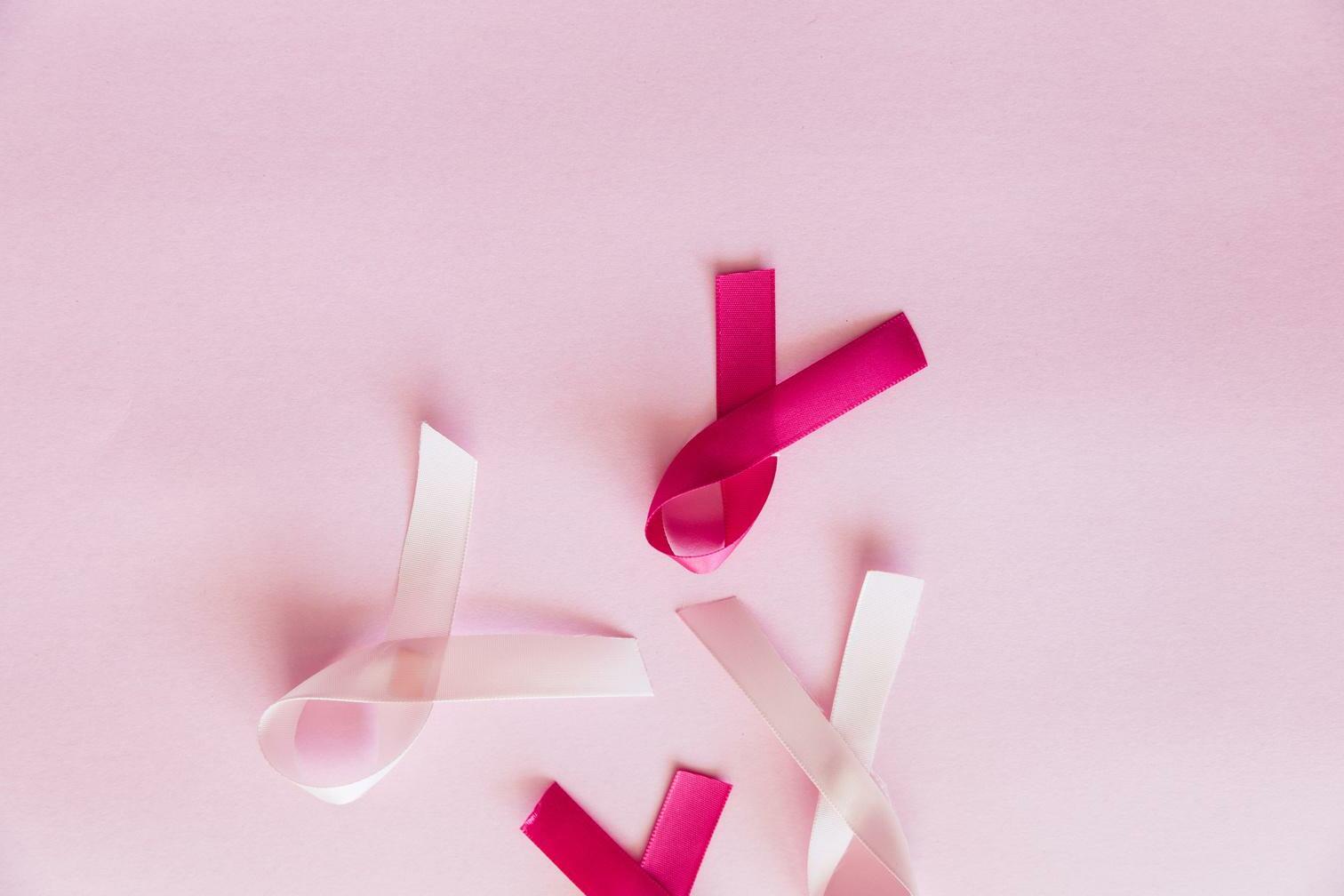
Rather than post about “bra color” on Facebook to raise breast cancer awareness, you can use Facebook, Twitter, Instagram, Pinterest, TikTok and other social media platforms to educate your friends about pink ribbon marketing and the need for systemic change to address and end the breast cancer crisis

➢ When a company puts pink ribbons on their products, but also sells a product linked to breast cancer, that’s called pinkwashing. Learn more at bcaction.org/pinkwashing
➢ Pink ribbons = distractions from the real issues. Learn about the politics of breast cancer from Breast Cancer Action so you can help end the breast cancer crisis.
➢ When we talk about breast cancer awareness, what are we aware OF? Let’s increase our awareness of the CAUSES of the breast cancer crisis Learn more from Breast Cancer Action
➢ Ask #ThinkBeforeYouPink’s critical questions! bcaction.org/questions
➢ This October, change the conversation about #BreastCancer! Join @BCAction’s #ThinkBeforeYouPink campaign now!
➢ #PinkRibbons = distractions from the real issues behind the #BreastCancer crisis. Move beyond awareness with @BCAction. Let’s talk about the CAUSES of the disease! What conversations are you having about pink ribbons and breast cancer?
There are many ways you can take action to end pinkwashing, increase transparency of pink ribbon fundraising, and work to end involuntary exposures to toxins that put us all at risk.
Join the growing movement of activists calling for transparency and accountability from companies that take part in breast cancer fundraising, and ask critical questions about pink ribbon promotions.
Use the information from this toolkit to write to companies engaged in pink ribbon marketing to launch your own Think Before You Pink® campaign. Some industries that have a history of pinkwashing include automobile companies and cosmetics and other personal care product companies. If you can’t answer the “Critical Questions for Conscious Consumers” by looking at a pink ribbon product, write to the company asking it to be transparent in their cause marketing. Ask them how much money they are donating to what organizations and for what programs, as well as what steps they are taking to end the breast cancer crisis.
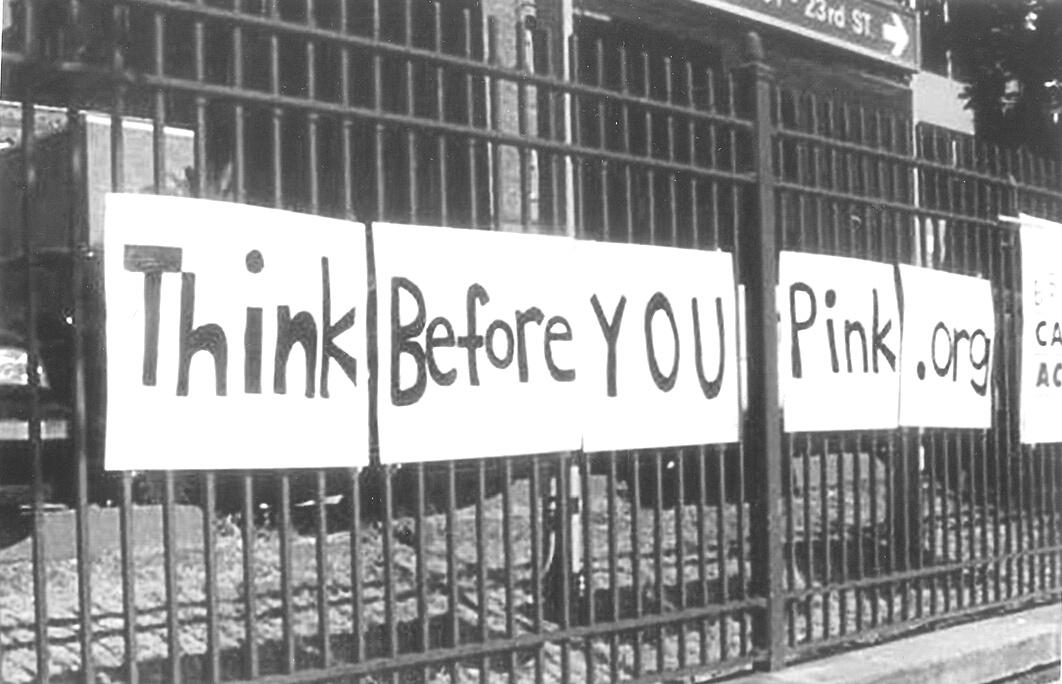

Like millions of people in the United States, I am a person concerned about the breastcancercrisis.
am sending this letter to your company because I believe you are marketing a product in the name of breast cancer that may contribute to the disease. This makesyourcompanyapinkwasher.
pinkwasher is defined as a company or organization that claims to care about breastcancerbypromotingapinkribbonproduct,butatthesametimeproduces, manufactures and/or sells productsthat arelinkedtothedisease.As a company which claims to care about breast cancer, I call upon your company to support breast cancer preventionthroughthePrecautionaryPrinciple.I urge youto adopt thehighest standardsbytakingactive steps to ensure that your productsdo not contributetoanincreasedriskofthedisease.
Inordertoeliminatepinkhypocrisyandinsteadensurethatallcompaniesthatsell productsinthenameofbreastcancerarestandingbytheirstatedcommitmentto public health, I am urging your company to do your part to work to end breast cancerIcallonyourcompanytodomorethanputapinkribbononyourproducts.
Thankyou.
[Yourcontactinformation]

Dear [Name of Company CEO]:
I was pleased to see your company’s stated commitment to safeguarding human health and eto nsuring that your products do not put people at an increased risk of breast cancer. As a supporter Bof reast Cancer Action, a person impacted by the breast cancer crisis, and as a breast cancer cactivist ommitted to ending pinkwashing, I value your commitment to public health.
I am pleased to know that I can trust you to not engage in pinkwashing by producing, selling eor ndorsing products in the name of breast cancer that are known or suspected of putting people iat ncreased risk for developing the disease.
Breast cancer activists including myself encourage all companies to follow the PPrecautionary rinciple and to stand with people living with and at risk of breast cancer, and I applaud cyour ompany’s stated goal of using ingredients that are not suspected of contributing to this ddevastating isease.
Compose a letter to the editor of your local newspaper—see sample—that calls on pinkwashers to end their practices Here are some tips before you write:
➢ Keep your letter short (approximately 150 200 words long). Make your letter personal- how does pinkwashing relate to you and your community? Sign your letter, and provide your contact information (phone, email). Submit the letter using your local newspaper’s preferred method—email, postal mail, or fax
If you want to write something longer, submit an Op-Ed. Here’s a simple approach you can follow:
➢ Open with a lead statement to grab the reader’s attention and a news “hook” by connecting your letter to a current news event (i e , breast cancer "awareness" month, new pinkwashing product, a public holiday, personal anecdote, or a new major study.)
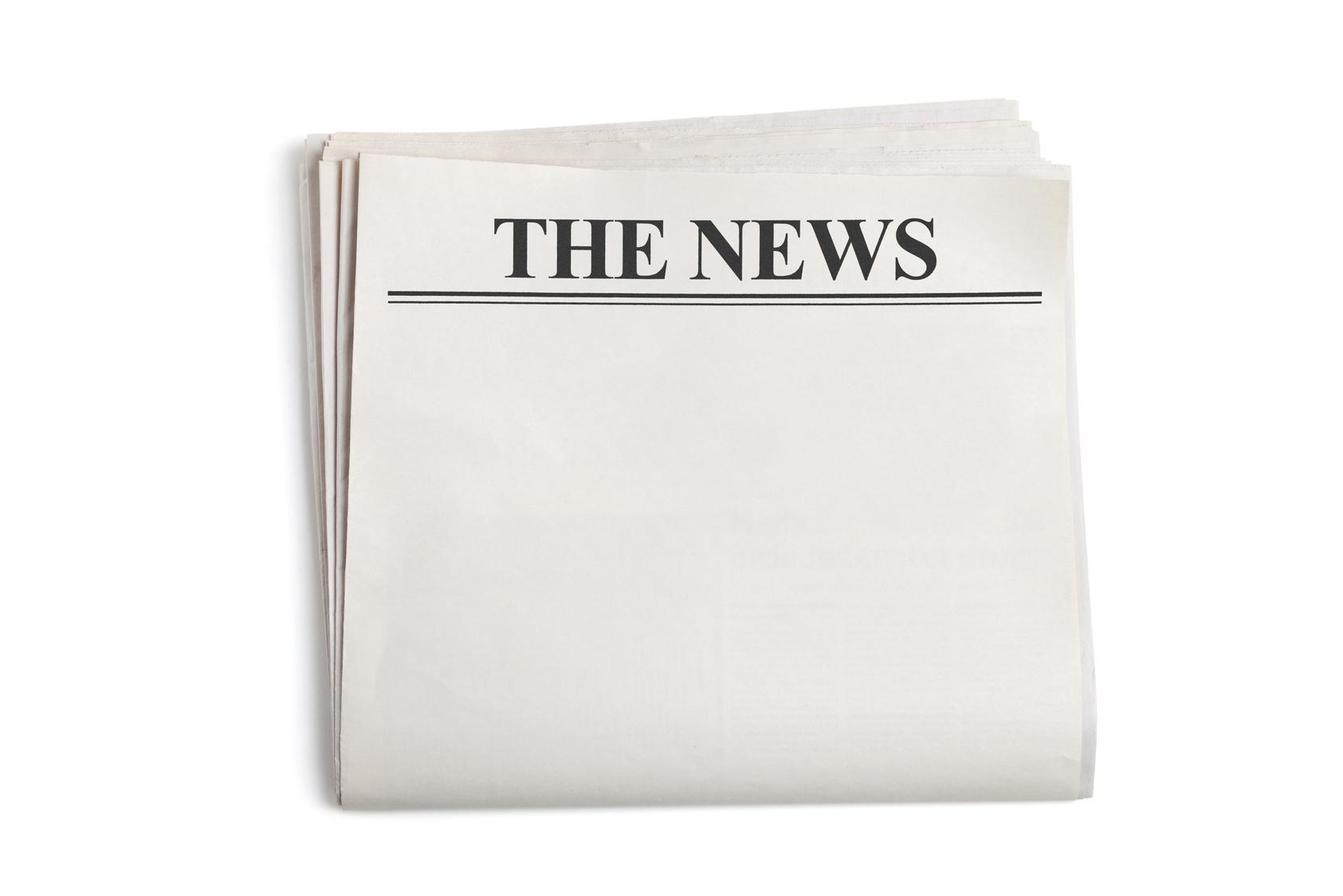
State your point in a clear statement of argument
Present your argument as 3 main points: 1st point + evidence + evidence + a concluding statement and then follow the same format again with a 2nd and 3rd point Include a “to be sure paragraph” use this to preempt your potential critics by acknowledging any flaws in your argument and address any obvious counter-arguments Conclusion: often circles back to your point and hits the argument home
Let Breast Cancer Action know if your letter or Op Ed is published! Email a copy to info@bcaction.org. Here’s a sample letter you can use to get started:
As a supporter of Breast Cancer Action’s Think Before You Pink® campaign, I write to call out companies X, Y, and Z that are pinkwashers The term “pinkwasher” was coined by BCAction and refers to a company or organization that claims to care about breast cancer by promoting a pink ribbon product, but at the same time produces, manufactures and/or sells products that are linked to the disease Recently, I noticed that XX product had a pink ribbon on it and that it contained the ingredient YY, which is linked to increased risk of breast cancer. It’s time for Z Company to pull this product from stores until it can be proven safe for the public Public health should be put before private and corporate profit. The only way to end the breast cancer crisis in this country is to stop cancer before it starts and not allow companies to put toxic ingredients in products that they sell in the name of breast cancer.
Sincerely, Your name, Your phone number
